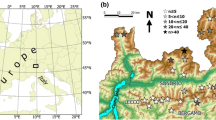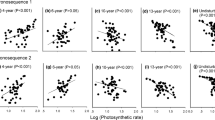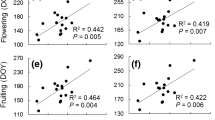Abstract
Understanding how biotic interactions and abiotic conditions affect plant performance is important for predicting changes in ecosystem function and services in variable environments. We tested how performances of Astragalus rigidulus and Potentilla fruticosa change along gradients of biotic interactions (represented by plant species richness, abundance of the dominant plant species Kobresia pygmaea, and herbivory intensity) and abiotic conditions (represented by elevation, aspect, and slope steepness) across a semi-arid landscape in central Tibet. Redundancy analyses showed that the biotic variables explained 30 and 39 % of the variation in overall performance of A. rigidulus (P = 0.03) and P. fruticosa (P = 0.01), respectively. Abiotic variables did not contribute significantly to variation among A. rigidulus populations. Plant size decreased with species richness in both species and was larger on south- rather than north-facing slopes. Reproductive effort for both species was significantly negatively related to the abundance of K. pygmaea and both species had larger reproductive effort on south- rather than north- and west-facing slopes. The proportion of biomass allocated to sexual reproduction in P. fruticosa was negatively correlated with K. pygmaea abundance and herbivory intensity. The population density of P. fruticosa was positively related to elevation, species richness, and K. pygmaea abundance. We conclude that plant performance at a local scale was more strongly related to biotic than abiotic conditions, but different components of plant performance responded differently to predictor variables and the responses were species-specific. These findings have important implications for rangeland management under changing environmental conditions.


Similar content being viewed by others
References
Auerbach M, Shmida A (1987) Spatial scale and the determinants of plant species richness. Trends Ecol Evol 2:238–242. doi:10.1016/0169-5347(87)90005-X
Austin MP (2007) Species distribution models and ecological theory: a critical assessment and some possible new approaches. Ecol Model 200:1–19. doi:10.1016/j.ecolmodel.2006.07.005
Billings WD (1973) Arctic and alpine vegetations: similarities, differences, and susceptibility to disturbance. Bioscience 23:697–704. doi:10.2307/1296827
Borcard D, Legendre P, Drapeau P (1992) Partialling out the spatial component of ecological variation. Ecology 73:1045–1055. doi:10.2307/1940179
Boulangeat I, Gravel D, Thuiller W (2012) Accounting for dispersal and biotic interactions to disentangle the drivers of species distributions and their abundances. Ecol Lett 15:584–593. doi:10.1111/j.1461-0248.2012.01772.x
Callaway RM, Brooker RW, Choler P, Kikvidze Z, Lortie CJ, Michalet R, Paolini L, Pugnaire FI, Newingham B, Aschehoug ET, Armas C, Kikodze D, Cook BJ (2002) Positive interactions among alpine plants increase with stress. Nature 417:844–848. doi:10.1038/nature00812
Cerabolini B, Pierce S, Luzzaro A, Ossola A (2010) Species evenness affects ecosystem processes in situ via diversity in the adaptive strategies of dominant species. Plant Ecol 207:333–345. doi:10.1007/s11258-009-9677-1
Crawley MJ (2007) The R Book. Wiley, Chichester
Cross MS, Harte J (2007) Compensatory responses to loss of warming-sensitive plant species. Ecology 88:740–748. doi:10.1890/06-1029
Dong SK, Wang XX, Liu SL, Li YY, Su XK, Wen L, Zhu L (2015) Reproductive responses of alpine plants to grassland degradation and artificial restoration in the Qinghai-Tibetan Plateau. Grass Forage Sci 70:229–238. doi:10.1111/gfs.12114
Dorji T, Totland Ø, Moe SR (2013) Are droppings, distance from pastoralist camps, and pika burrows good proxies for local grazing pressure? Rangel Ecol Manag 66:26–33. doi:10.2111/rem-d-12-00014.1
Dorji T, Moe SR, Klein AJ, Totland Ø (2014) Plant species richness, evenness and composition along environmental gradients in an alpine meadow grazing ecosystem in central Tibet, China. Arct Antarct Alp Res 46:308–326. doi:10.1657/1938-4246-46.2.308
Elkington T, Woodell S (1963) Potentilla fruticosa L. J Ecol 51:769–781. doi:10.2307/2257763
Elmendorf SC, Henry GHR, Hollister RD, Björk RG, Bjorkman AD, Callaghan TV, Collier LS, Cooper EJ, Cornelissen JHC, Day TA, Fosaa AM, Gould WA, Grétarsdóttir J, Harte J, Hermanutz L, Hik DS, Hofgaard A, Jarrad F, Jónsdóttir IS, Keuper F, Klanderud K, Klein JA, Koh S, Kudo G, Lang SI, Loewen V, May JL, Mercado J, Michelsen A, Molau U, Myers-Smith IH, Oberbauer SF, Pieper S, Post E, Rixen C, Robinson CH, Schmidt NM, Shaver GR, Stenström A, Tolvanen A, Totland Ø, Troxler T, Wahren C-H, Webber PJ, Welker JM, Wookey PA (2012) Global assessment of experimental climate warming on tundra vegetation: heterogeneity over space and time. Ecol Lett 15:164–175. doi:10.1111/j.1461-0248.2011.01716.x
Eskelinen A (2008) Herbivore and neighbour effects on tundra plants depend on species identity, nutrient availability and local environmental conditions. J Ecol 96:155–165. doi:10.1111/j.1365-2745.2007.01322.x
Fan DM, Yang YP (2009) Altitudinal variations in flower and bulbil production of an alpine perennial, Polygonum viviparum L. (Polygonaceae). Plant Biol 11:493–497. doi:10.1111/j.1438-8677.2008.00188.x
Fournier DA, Skaug HJ, Ancheta J, Ianelli J, Magnusson A, Maunder M, Nielsen A, Sibert J (2012) AD Model Builder: using automatic differentiation for statistical inference of highly parameterized complex nonlinear models. Optim Method Softw 27:233–249. doi:10.1080/10556788.2011.597854
Giannini TC, Chapman DS, Saraiva AM, Alves-dos-Santos I, Biesmeijer JC (2013) Improving species distribution models using biotic interactions: a case study of parasites, pollinators and plants. Ecography 36:649–656. doi:10.1111/j.1600-0587.2012.07191.x
Grime JP (1973) Competitive exclusion in herbaceous vegetation. Nature 242:344–347. doi:10.1038/242344a0
Grime JP (1998) Benefits of plant diversity to ecosystems: immediate, filter and founder effects. J Ecol 86:902–910. doi:10.1046/j.1365-2745.1998.00306.x
Hardin G (1960) The competitive exclusion principle. Science 131:1292–1297. doi:10.1126/science.131.3409.1292
Kaarlejärvi E, Olofsson J (2014) Concurrent biotic interactions influence plant performance at their altitudinal distribution margins. Oikos 123:943–952. doi:10.1111/oik.01261
Kang S, Yang Y, Zhu L, Ma Y (2011) Modern environmental processes and changes in the Nam Co basin, Tibetan Plateau. Beijing Meteorological Press, Beijing, China
Klein JA, Harte J, Zhao XQ (2007) Experimental warming, not grazing, decreases rangeland quality on the Tibetan Plateau. Ecol Appl 17:541–557. doi:10.1890/05-0685
Körner C (2003) Alpine plant life: functional plant ecology of high mountain ecosystems. Springer, Berlin
le Roux PC, Lenoir J, Pellissier L, Wisz MS, Luoto M (2013) Horizontal, but not vertical, biotic interactions affect fine-scale plant distribution patterns in a low-energy system. Ecology 94:671–682. doi:10.1890/12-1482.1
Lepš J, Šmilauer P (2003) Multivariate analysis of ecological data using CANOCO. Cambridge Univ Press, Cambridge
Li WJ, Li JH, Lu JF, Zhang RY, Wang G (2010) Legume-grass species influence plant productivity and soil nitrogen during grassland succession in the eastern Tibet Plateau. Appl Soil Ecol 44:164–169. doi:10.1016/j.apsoil.2009.12.001
Louda SM, Keeler KH, Holt RD (1990) Herbivore influences on plant performance and competitive interactions. In: Grace JB, Tilman D (eds) Perspectives on plant competition. Academic Press, San Diego, pp 413–444
McGlinn DJ, Palmer MW (2009) Modeling the sampling effect in the species–time–area relationship. Ecology 90:836–846. doi:10.1890/08-0377.1
Meineri E, Skarpaas O, Vandvik V (2012) Modeling alpine plant distributions at the landscape scale: do biotic interactions matter? Ecol Model 231:1–10. doi:10.1016/j.ecolmodel.2012.01.021
Miehe G, Miehe S, Bach K, Nolling J, Hanspach J, Reudenbach C, Kaiser K, Wesche K, Mosbrugger V, Yang YP, Ma YM (2011) Plant communities of central Tibetan pastures in the Alpine Steppe/Kobresia pygmaea ecotone. J Arid Environ 75:711–723. doi:10.1016/j.jaridenv.2011.03.001
Milchunas DG, Lauenroth WK, Burke IC, Detling JK (2008) Effects of grazing on vegetation. In: Lauenroth WK, Burke IC (eds) Ecology of the shortgrass steppe: a long term perspective. Oxford University Press, New York, pp 389–446
Mitchell CE, Agrawal AA, Bever JD, Gilbert GS, Hufbauer RA, Klironomos JN, Maron JL, Morris WF, Parker IM, Power AG (2006) Biotic interactions and plant invasions. Ecol Lett 9:726–740. doi:10.1111/j.1461-0248.2006.00908.x
Nielsen A, Totland Ø, Ohlson M (2007) The effect of forest management operations on population performance of Vaccinium myrtillus on a landscape-scale. Basic Appl Ecol 8:231–241. doi:10.1016/j.baae.2006.05.009
Økland RH, Eilertsen O (1994) Canonical correspondence analysis with variation partitioning: some comments and an application. J Veg Sci 5:117–126. doi:10.2307/3235645
Pearson RG, Dawson TP (2003) Predicting the impacts of climate change on the distribution of species: are bioclimate envelope models useful? Glob Ecol Biogeogr 12:361–371
R-Development-Core-Team (2012) R: a language and environment for statistical computing. R Foundation for Statistical Computing, Vienna
Scherrer D, Körner C (2011) Topographically controlled thermal-habitat differentiation buffers alpine plant diversity against climate warming. J Biogeogr 38:406–416. doi:10.1111/j.1365-2699.2010.02407.x
Selmants PC, Zavaleta ES, Pasari JR, Hernandez DL (2012) Realistic plant species losses reduce invasion resistance in a California serpentine grassland. J Ecol 100:723–731. doi:10.1111/j.1365-2745.2011.01949.x
Song M, Tian Y, Xu X, Hu Q, Ouyang H (2006) Interactions between root and shoot competition among four plant species in an alpine meadow on the Tibetan Plateau. Acta Oecol 29:214–220. doi:10.1016/j.actao.2005.10.005
Speed JD, Austrheim G, Hester AJ, Mysterud A (2012) Elevational advance of alpine plant communities is buffered by herbivory. J Veg Sci 23:617–625. doi:10.1111/j.1654-1103.2012.01391.x
ter Braak CJF, Prentice IC (1988) A theory of gradient analysis. Adv Ecol Res 34:235–282. doi:10.1016/S0065-2504(08)60183-X
ter Braak CJF, Smilauer P (2002) CANOCO reference manual on CanoDraw for Windows user’s guide: software for canonical community ordination (version 4.5). Microcomputer Power, Ithaca
Totland Ø, Nyléhn J (1998) Assessment of the effects of environmental change on the performance and density of Bistorta vivipara: the use of multivariate analysis and experimental manipulation. J Ecol 86:989–998. doi:10.1046/j.1365-2745.1998.00318.x
Wang Y, Chu C, Maestre FT, Wang G (2008) On the relevance of facilitation in alpine meadow communities: an experimental assessment with multiple species differing in their ecological optimum. Acta Oecol 33:108–113. doi:10.1016/j.actao.2007.10.002
Xu J, Michalet R, Zhang JL, Wang G, Chu CJ, Xiao S (2010) Assessing facilitative responses to a nurse shrub at the community level: the example of Potentilla fruticosa in a sub-alpine grassland of northwest China. Plant Biol 12:780–787. doi:10.1111/j.1438-8677.2009.00271.x
Yang BJ, Qiao N, Xu XL, Ouyang H (2011) Symbiotic nitrogen fixation by legumes in two Chinese grasslands estimated with the N-15 dilution technique. Nutr Cycl Agroecosyst 91:91–98. doi:10.1007/s10705-011-9448-y
Acknowledgments
We appreciate two anonymous reviewers’ very constructive comments on our MS. We thank the University Co-operation Tibet-Norway Network for providing funds for Tsechoe Dorji to conduct his Ph.D. studies. This work is also partially supported by the National Science Foundation of China (31470524, 41230750 and 31272488), Programs from Strategic Priority Research Program (B) of the Chinese Academy of Sciences (XDB03030403) and National Basic Research Programs of China (2013CB956000). We thank Mr. Chengding Li and Ms. Hailin Li from Tibet University for fieldwork assistance.
Author information
Authors and Affiliations
Corresponding author
Electronic supplementary material
Below is the link to the electronic supplementary material.
About this article
Cite this article
Dorji, T., Moe, S.R., Klein, J.A. et al. Performance of two alpine plant species along environmental gradients in an alpine meadow ecosystem in central Tibet. Ecol Res 31, 417–426 (2016). https://doi.org/10.1007/s11284-016-1350-2
Received:
Accepted:
Published:
Issue Date:
DOI: https://doi.org/10.1007/s11284-016-1350-2




